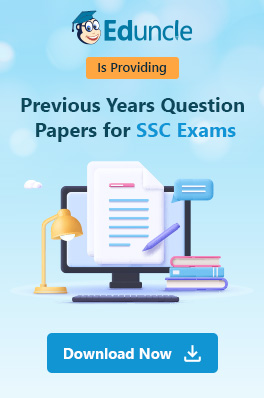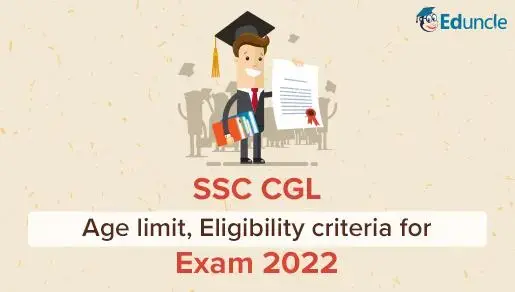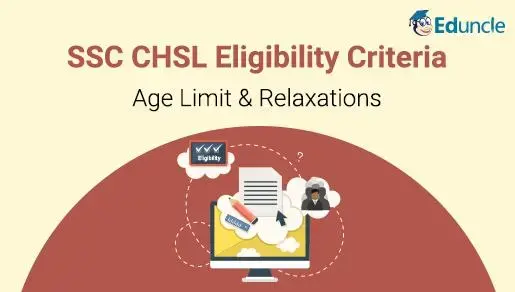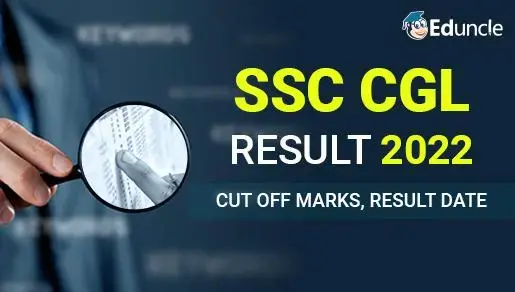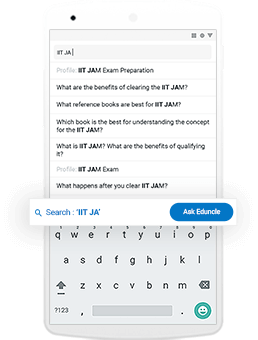As you all know, the SSC CHSL Exam is a great opportunity for all those candidates who have passed the 10+2 examination and are now seeking for the job in any of the Government Sectors.
The candidates who are aspiring the exam must be well prepared to qualify it in their first attempt.
Eduncle Experts advice all the aspirants to solve as many as SSC CHSL Sample Questions they can solve. As this can benefit you in two ways - It will boost up your knowledge regarding the questions format and enhance your speed and accuracy as well.
Below in this blog we are sharing out some sample questions for each section and tricks to solve them in minimal time.
Let’s see how much time you should spend on each section while giving up the exam.
We hope that the above time allocation approach will be very helpful to you while attempting the questions in the exam.
In such cases, the candidates should prepare themselves so brilliantly that the moment they read the question, they should know what technique will work out to reach its conclusion soon.
For their ease, Eduncle is presenting a list of Formulas and Tricks for SSC CHSL Quantitative Aptitude Section.
Please select any topic from the list below to explore the list of its formulas and short methods!
Number System Formulas and Tricks PDF [Download here]
1 + 2 + 3 + 4 + 5 + … + n = n(n + 1)/2
(12 + 22 + 32 + ..... + n2) = n ( n + 1 ) (2n + 1) / 6
(13 + 23 + 33 + ..... + n3) = (n(n + 1)/ 2)2
Sum of first n odd numbers = n2
Sum of first n even numbers = n (n + 1)
(a + b)*(a - b) = (a2 - b2)
(a + b)*2 = (a2 + b2 + 2ab)
(a - b)*2 = (a2 + b2 - 2ab)
(a + b + c)*2 = a2 + b2 + c2 + 2(ab + bc + ca)
(a3 + b3) = (a + b)*(a2 - ab + b2)
(a3 - b3) = (a - b)*(a2 + ab + b2)
(a3 + b3 + c3 - 3abc) = (a + b + c)*(a2 + b2 + c2 - ab - bc - ac)
When a + b + c = 0, then a3 + b3 + c3 = 3abc
(a + b)*n = an + (nC1)*an-1b + (nC2)*an-2b2 + … + (nCn-1)*abn-1 + bn.
For more Number System Short Tricks Methods, please visit - How to Solve Number System Questions in Exams [Short trick PDF].
HCF & LCM Formulas and Tricks PDF [Download here]
Product of two numbers a and b (a*b) = Their HCF * Their LCM.But a*b*c ≠ HCF*LCM
#Note: HCF of two or more numbers is the greatest number which divide all of them without any remainder.
LCM of two or more numbers is the smallest number which is divisible by all the given numbers.
HCF of given fractions = (HCF of Numerator)/(LCM of Denominator)
HCF of given fractions = (LCM of Denominator)/(HCF of Numerator)
If d = HCF of a and b, then there exist unique integer m and n, such that -> d = am + bn.
Some important HCF and LCM Rules -
Factors and Multiples
If number a, divided another number b exactly, we say that a is a factor of b.
In this case, b is called a multiple of a.
Co-primes
Two numbers are said to be co-primes if their H.C.F. is 1.
HCF of a given number always divides its LCM.
Methods of finding HCF of two or more numbers
Method 1: Prime Factors Method
Break the given numbers into prime factors and then find the product of all the prime factors common to all the numbers.
The product will be the required HCF.
Example
If you have to find the HCF of 42 and 70.
Then 42 = 2*3*7
And 72 = 2*5*7
Common factors are – 2 and 7 so, HCF = 2*7 =14.
Method 2: Division Method
Divide the greater number by the smaller number, divide the divisor by the remainder, divide the remainder by the next remainder and so on until no remainder is left. The last divisor is required HCF.
To check the complete procedure in example format, then please visit here – Number System Division and Remainder Rules.
Method 3: HCF of Large Numbers
Find the obvious common factor from both the numbers and remove it.
Also remove the prime number (if any found).
Now perform division method to remaining numbers and find the HCF.
Check out the example for better understanding.
Example
If you have to find out the HCF of 42237 and 75582.
Then first check out for the common factor –
42237 = 4693*9
75582 = 2*9*4199
Here we can remove 9 and 2 is a prime number so we can also extract this.
Now calculate with remaining numbers.
After performing Division method - 4693/4199, we get the remainder 494.
Now the remainder 494 is divided by 2 but divisor 4199 is not.
So it should be proceeded further after dividing 494 by 2 i.e. 247.
Now performing division method as – 4199/247, we get the remainder as 0.
Now by multiplying 247 with 9 we can have our required HCF i.e. 247*9=2223.
Methods of finding LCM of two or more numbers
Method 1: Prime Factors Method
Resolve the given numbers into their Prime Factors and then find the product of the highest power of all the factors that occur in the given numbers. The product will be the LCM.
Example
LCM of 8,12,15 and 21.
Now 8 = 2*2*2 = 23
12 = 2*2*3 = 22*3
15 = 3*5
21 = 3*7
So highest power factors occurred are – 23, 3, 5 and 7
LCM = 23*3*5*7 = 840.
Know which kind of questions asked in SSC CHSL Exam? Get Free SSC CHSL Paper Analysis by Experts.
Average Formulas and Tricks PDF [Download here]
Average = (Total of data) / (No. of data)
Age of New Entrant = New Average + No. of Old Members * Increase
Weight of New Person = Weight of Removed Person + No. Of Persons * Increase In Average
Number of Passed Candidates = Total Candidates * (Total Average – Failed Average) / (Passed Average – Failed Average)
Number of Failed Candidates = Total Candidates * (Passed Average – Total Average) / (Passed Average – Failed Average)
Age of New Person = Age of Removed Person – No. of Persons * Decrease in Average Age
Average after x innings = Total Score – Increment in Average * y innings
If a person travels a distance at a speed of x km/hr and the same distance at a speed of y km/hr, then the average speed during the whole journey is given by – 2xy / (x+y) km/hr.
If half of the journey is travelled at a speed of x km/hr and the next half at a speed of y km/hr, then average speed during the whole journey is 2xy / (x+y) km/hr.
If a man goes to a certain place at a speed of x km/hr and returns to the original place at a speed of y km/hr, then the average speed during up and down journey is 2xy / (x+y) km/hr.
If a person travels 3 equal distances at a speed of x km/hr, y km/hr and z km/hr respectively, then the average speed during the whole journey is
3xyz / (xy+yz+zx) km/hr.
- If decrease in average = x
- Increase in expenditure = y
- Increase in no. of students = z
- And number of students (originally) = N, then
- The original expenditure = N * [ x*(N+z) + y ] / z ]
Problems on Ages, Trains, Boats and Streams Formulas and Tricks PDF [Download here]
Problems on Ages Formulas - Formulas –
If the current age is x, then n times the age is nx.
If the current age is x, then age n years later/hence = x + n.
If the current age is x, then age n years ago = x - n.
The ages in a ratio a : b will be ax and bx.
If the current age is x, then 1/n times the age is x/n.
Quicker Methods –
To find out son’s age, use this formula –
If t1 years earlier the father’s age was x times that of his son. At present the father’s age is y times that of his son. Then the present age of son will be?
Son’s Age = t1 (x-1) / (x-y)
If present age of the father is y times the age of his son. After t2 years the father’s age become z times the age of his son. Then the present age of son will be? Son’s Age = (z-1)t1 / (y-z)
t1 years earlier, the age of the father was x times the age of his son. After t2 years, the father’s age becomes x times the age of his son. Then the present age of son will be?
Son’s Age = [(z-1)t2 + (x-1)t1] / (x-z)
Son’s or Daughter’s Age = [Total ages + No. of years ago (Times - 1)] / (Times+1)
Son’s or Daughter’s Age = [Total ages - No. of years ago (Times - 1)] / (Times+1)
Father : Son
Present Age = x : y
T years before = a : b
Then, Son’s age = y * [ T(a-b) / Difference of cross product ]
And Father’s age = x * [ T(a-b) / Difference of cross product ]
Problem on Trains Formulas -
When x and y trains are moving in opposite direction, then their relative speed = Speed of x + Speed of y
When x and y trains are moving in same direction, then their relative speed = Speed of x - Speed of y
When a train passes a platform, it should travel the length equal to the sum of the lengths of train & platform both.
Distance = (Difference in Distance) * [(Sum of Speed) / (Diff in Speed)]
Length of Train = [(Length of Platform) / (Difference in Time)] * (Time taken to cross a stationary pole or man)
Speed of faster train = (Average length of two trains) * [(1/Opposite Direction’s Time) + (1/Same Direction’s Time)]
Speed of slower train = (Average length of two trains) * [(1/Opposite Direction’s Time) - (1/Same Direction’s Time)]
Length of the train = [(Difference in Speed of two men) * T1 * T2)] / (T2-T1)
Length of the train = [(Difference in Speed) * T1 * T2)] / (T1-T2)
Length of the train = [(Time to pass a pole) * (Length of the platform)] / (Diff in time to cross a pole and platform)
First train’s starting point = S1 * [{(Total Distance) – S2 * (T1-T2)} / (S1+S2)]
S2 = S1 * Square root of [(Time taken by first train after meeting) / (time taken by second train after meeting)]
Boats and Streams Formulas -
If the speed of the boat is x and if the speed of the stream is y while upstream then the effective speed of the boat is = x - y
And if downstream then the speed of the boat = x + y
If x km/hr be the man’s rate in still water and y km/hr is the rate of the current. Then
Man’s rate with current = x + y
Man’s rate against current = x – y
A man can row x km/hr in still water. If in a stream which is flowing at y km/hr, it takes him z hrs to row to a place and back, the distance between the two places is = z * (x2 – y2) / 2x
A man rows a certain distance downstream in x hours and returns the same distance in y hours. If the stream flows at the rate of z km/hr, then the speed of the man in still water is given by – z* (x + y) / (y - x) km/hr.
Man’s rate against current = Man’s rate with current – 2 * rate of current
Distance = Total Time * [(Speed in still water)2 – (Speed of current)2] / 2 * (Speed in still water)
Speed in Still Water = [(Rate of Stream) * (Sum of upstream and downstream time)] / (Diff of upstream and downstream time)
Get the Free SSC CHSL Study Material designed by Experts
Time, Distance & Work Formulas and Tricks PDF [Download here]
Time and Work Formulas -
If M1 persons can do W1 work in D1 days and M2 persons can do W2 work in D2 days, then the formula will be -M1 * D1 * W1 = M2 * D2 * W2
If we add Time for both the groups T1 and T2 respectively, then the formula will become –M1 * D1 * T1 * W1 = M2 * D2 * T2 * W2
And if we add efficiency for both the groups E1 and E2 respectively, then the formula becomes –M1 * D1 * T1 * E1 * W1 = M2 * D2 * T2 * E2 * W2 If A can do a piece of work in x days and B can do it in y days, then A and B working together will do the same work in [(x*y)/(x+y)]
If A, B and C can do a work in x, y and z days respectively, then all of them working together can finish the work in [(x*y*z) / (xy + yz + zx)]
If A and B together can do a piece of work in x days and A can do it in y days, then B alone can do the work in (x*y) / (x-y)
Original Number of Workers = (No. of more workers * No. of days taken by the second group) / No. of less days
Time and Distance Formulas -
Speed = Distance / Time
If the speed of a body is changed in the ratio a:b, then the ratio of the time taken changes in the ration b:a.
If a certain distance is covered at x km/hr and the same distance is covered at y km/hr, then the average speed during the whole journey is 2xy / (x+y) km/hr.
Required Distance = [(Product of two speeds) / (Difference of two speeds)] * Diff between arrival times.
Required Distance = Total Time Taken * [(Product of two speeds) / (Addition of two speeds)]
Distance = (2*Time*S1*S2) / (S1 + S2)
Where S1 = Speed during first half and S2 = Speed during second half of journey
Meeting point’s distance from starting point = (S1 * S2 * Difference in time) / (Difference in speed)
Distance travelled by A = 2 * Distance of two points (a / a+b)
Distance = [(Multiplication of speeds) / (Difference of Speeds)] * (Difference in time to cover the distance)
Meeting Time = (First’s starting time) + [(Time taken by first) * (2nd’s arrival time – 1st’s starting time)] / (Sum of time taken by both)
Time of rest per hour = (Difference of Speed) / (Speed without Stoppage)
Distance = (Total Time) * (Multiplication of two speeds) / (Sum of Speeds)
Speed = [2 * (Increase in speed) * (Decrease in speed)] / Difference in Increase and Decrease in Speeds
Percentage Formulas and Tricks PDF [Download here]
Percentage = [Value / Total Value * 100]
If two values are respectively x% and y% more than a third value, then the first is the (100+x) / (100+y) *100% of the second.
If A is x% of C and B is y% of C, then A is x/y*100% of B.
x% of quantity is taken by the first, y% of the remaining is taken by the second and z% of the remaining is taken by third person. Now is A is left in the fund then there was (A*100*100*100) / (100-x) (100-y) (100-z) in the beginning.
x% of quantity is added. Again y% of increased quantity is added. Again z% of the increased quantity is added. Now, it becomes A, then the initial amount is given by (A*100*100*100) / (100+x) (100+y) (100+z)
If the original population of a town is P and the annual increase is r%, then the population in n years will be – P + P*r/100 = P*(1+r/100)
The population of a town is P. It increases by x% during the 1st year, increases by y% during the 2nd year and again increases by z% during the third year. Then, the population after 3 years will be - P*(100+x)(100+y)(100+z) / 100*100*100
When the population decreases by y% during the 2nd year, while for the 1st and 3rd years, it follows the same, the population after 3 years will be –
P*100+x)(100-y)(100+z) / 100*100*100
If the price of a commodity increases by r%, then the reduction in consumption so as not to increase the expenditure, is (r/100+r) * 100%
If the price of a commodity decreases by r%, then the increase in consumption so as not to decrease the expenditure, is (r/100-r) * 100%
If the first value is r% more than the second value, then the second is (r/100+r) * 100% less than the first value.
If the first value is r% less than the second value, then the second is (r/100-r) * 100% more than the first value.
If the value of a number is first increased by x% and later decreased by x%, the net change is always a decrease which is equal to x% of x or x2/100.
If the value of a number is first increased by x% and later decreased by y%, then there is [x-y-(x*y/100)] % increase or decrease, according to the =ve or –ve sign respectively.
If the order of increase and decrease is changes, the result remain unaffected.
If the value is increased by x% and y% then the final increase is [x+y+(x*y/100)] %.
If the price of a commodity is diminished by x% and its consumption is increased by y%
Or
If the price of a commodity is increased by x% and its consumption is decreased by y%
Then the effect on revenue is = [Inc. % Value – Dec. % Value – (Inc. % Value * Dec. % Value/100)].
The passing marks in an examination is x%. If a candidates who scores y marks, fails by z marks, then the max marks –
M = 100*(y+z)/x.
A candidate scoring x% in an exam fails by ‘a’ marks, while another candidate who scores y% marks gets ‘b’ marks more than the min required pass marks. Then the max marks for the exam are -M = 100*(a+b) / (y-x).
In measuring the sides of rectangle, one side is taken x% in excess and the other y% in deficit. The error % in area calculated from the measurement is [x – y - (x*y/100)].
If the sides of triangle, rectangle, square, circle, rhombus are increased by x%, then its area is increased by [x * (x+200) / 100] % or [2*x + (x2/100)] %.
In an exam x% students failed in English and y% students failed in Maths. If z% of students failed in both,
Then the % of passed students in both subjects is = 100 – (x + y - z) or (100-x) + (100-y) + z.
Get Eduncle Study material for upcoming SSC CHSL Exam trusted by 4000+ selected students.
Profit & Loss Formulas and Tricks PDF [Download here]
Profit = Selling Price (SP) – Cost Price (CP)
Loss = Cost Price (CP) – Selling Price (SP)
Gain or Loss % = (Loss or Gain / CP) * 100 %
Gain % = [Error / (True Value – Error)] * 100 %
Gain % = [(True Weight – False Weight) / False Weight] * 100 %
Total % Profit = [(% Profit + % Less in wt) / (100 - % Less in wt)] * 100 %
Cost Price = (More Gain * 100) / Diff in % Profit
Selling Price = [More Rupees * (100 + % Final Gain)] / (%gain + %loss)
Cost Price = [(Initial Profit%) + (Inc. in Profit%)] * A / (Inc. in Profit%)
If CP of x articles is = SP of y articles, then Profit % = [(x –y) / y] * 100
Cost Price = (100 * More Charge) / (% Diff in Profit)
Selling Price = More Charge * (100+ First Profit%) / (% Diff in Profit).
Simple & Compound Interest Formulas and Tricks PDF [Download here]
Simple Interest Formulas -
SI = p*t*r/100
The annual payment that will discharge a debt of INR A due in t years at the rate of interest r% per annum is = (100 * A) / [(100 * t) + r*t* (t-1)]/2
P = (Interest * 100) / [(t1*r1) + (t2*r2) + (t3*r3) + …..]
Rate = [100 * (Multiple number of principal - 1)] / Time
Sum = (More Interest * 100) / (Time * More Rate)
Compound Interest Formulas -
When Interest is compounded annually - Amount = P [1 + (r/100)]t
When Interest is compounded half-yearly – Amount = P [1 + (r/200)]2t
When Interest is compounded quarterly – Amount = P [1 + (r/400)]4t
When rate of Interest is r1%, r2% and r3% then – Amount = P [1 + (r1/100)] * [1 + (r2/100)] * [1 + (r3/100)]
Simple Interest for 2 years = 2*r = 2r% of capital
Compound Interest for 2 years = [2r +(r2/100)]% of capital
Simple Interest for 3 years = 3*r = 3r% of capital
Compound Interest for 3 years = [3r +(3r
2/100) + (r
3/100
2)]% of capital
Download Free SSC CHSL Study Kit & Start Preparing Now
Simplification Formulas and Tricks PDF [Download here]
'BODMAS' Rule Through this rule, you can understand the correct sequence in which the operations are to be executed and this rule depicts the correct sequence in which the operations are to be executed and the sequence can be evaluated.Here are some rules of simplification given below- 1. B – Bracket
(First of all remove all the brackets strictly in the order (), {} and || and after removing the brackets, you can follow the below sequence)
2. O – Of
3. D - Division
4. M – Multiplication
5. A - Addition and
6. S - Subtraction
Modulus of a Real Number
Modulus of a real number a is defined as
| |a| = |
a, if a > 0 |
| -a, if a < 0 |
Thus, |5| = 5 and |-5| = -(-5) = 5.
Vinculum (or Bar)
When an expression contains Vinculum, before applying the 'BODMAS' rule, we simplify the expression under the Vinculum.
Mensuration Formulas and Tricks PDF [Download here]
Area of Rectangle = Length * Breadth
(Diagonal of Rectangle)2 = (Length)2 * (Breadth)2
Perimeter of Rectangle = 2 * (Length + Breadth)
Area of a Square = (Side)2 = 1/2 * (Diagonal)2
Perimeter of Square = 4 * Side
Area of 4 walls of a room = 2 * (Length + Breadth) * Height
Area of a parallelogram = (Base * Height)
Area of a rhombus = 1/2 * (Product of Diagonals)
Area of an Equilateral Triangle = Root of (3) / 4 * (Side)2
Perimeter of an Equilateral Triangle = 3 * Side
Area of an Isosceles Triangle = b/4 * root of 4a2 – b2
Area of Triangle = 1/2 * Base * Height
Area of Triangle = root of [s(s - a) * (s - b) * (s-c)]
Area of Trapezium = 1/2 * (Sum of parallel sides * perpendicular distance between them)
Circumference of a circle = 2*(22/7)*r
Area of a circle = (22/7) * r2
Area of a parallelogram = 2 * root of [s(s - a) * (s - b) * (s-d)]
Volume of cuboid = (l*b*h)
Whole Surface of cuboid = 2 * (lb + bh + lh) sq. units
Diagonal of Cuboid = Root of (l2 + b2 + h2)
Volume of a cube = a3
Whole Surface Area of cube = (6*a2)
Diagonal of Cube = Root of (3) * a
Volume of Cylinder = (22/7) * r2 * h
Curved Surface area of Cylinder = 2*(22/7)*r*h
Total Surface Area of Cylinder = [2*(22/7)*r*h] + {2*(22/7)*r2)
Volume of Sphere = (4/3) * (22/7) * r3
Surface Area of Sphere = 4 * (22/7) * r2
Volume of hemisphere = (2/3) * (22/7) * r3
Curved Surface area of hemisphere = 2 * (22/7) * r2
Whole Surface Area of hemisphere = 3 * (22/7) * r2.
Track Your Progress by Solving Free SSC CHSL Model Test Papers & Analyse Your exam Preparation. Download SSC CHSL Mock Test Now!
SSC CHSL Sample Questions [Topic Wise] – Solve and Test Your Performance Level!
To make you aware of the difficulty level of questions in SSC CHSL Exam, Eduncle is providing you some topic wise sample questions. Kindly solve them to practice well for the exam.
Quantitative Aptitude Sample Questions!
If you are good at performing fast calculation while solving the Maths questions, then SSC CHSL Quantitative Aptitude can be very scoring for you.
The questions come from 10+2 level Mathematics, so you need not to study the advance concepts of Maths. A respectable score can be obtained by gaining the enough knowledge of Basic Concepts and Fundamentals only.
Based on the previous years’ analysis, Experts have set the marking weightage of each topic from SSC CHSL Quantitative Aptitude Syllabus. Please check below –
| S. No. |
Topic |
Expected Marks |
| 1. |
Mensuration |
10 Marks |
| 2. |
Percentage + Profit/Loss + Ratio |
7-9 Marks |
| 3. |
Data Interpretation |
7 Marks |
| 4. |
Trigonometry |
5-6 Marks |
| 5. |
Algebra |
5 Marks |
| 6. |
Number System |
4 Marks |
| 7. |
Geometry |
4 Marks |
| 8. |
Time, Speed and Distance |
3 Marks |
| 9. |
Time and Work |
2-3 Marks |
| 10. |
SI + CI |
2 Marks |
Set your priority and take the important topics at first while doing preparation for the exam.
Download Free SSC CGL Study Kit & Start Preparing Now
Sample Questions for Practice Purpose!
Ques 1: A and B borrowed ` 3000 and ` 3200 respectively at the same rate of interest for 2.5 years. If B paid ` 40 more interest than A, find the rate of interest:
(A). 6%
(B). 5%
(C). 8%
(D). 4%
Answer: C
Ques 2: A can do a piece of work in 10 days, B in 15 days. They work together for 5 days; the rest of the work is finished by C in two more days. If they get Rs. 3000 as wages for the whole work, what are the daily wages of A, B and C respectively (in Rs):
(A). 150, 200, 250
(B). 200, 300, 450
(C). 150, 100, 50
(D). 300, 200, 250
Answer: D
Ques 3: A can lay railway track b/w two given stations in 16 days and B can do the same job in 12 days. With the help of C, they did the job in 4 days only. Then, C alone can do the job in how many days?
(A). 10 Days
(B). 9 * (1/5) Days
(C). 9 * (3/5) Days
(D). 9 * (2/5) Days
Answer: C
Ques 4: A rectangular field has to be fenced on three sides leaving a side of 20 Ft uncovered. If the area of the field is 680 sq. feet, how many feet of fencing will be required?
(A). 89
(B). 98
(C). 100
(D). 88
Answer: D
Ques 5: The remainder when 4^0 + 4^1 + 4^2 + 4^3 +……+ 4^40 is divided by 17 is?
(A). 8
(B). 4
(C). 16
(D). None of these
Answer: D
Ques 6: A cloth merchant sold half of his cloth at 20% profit, half of the remaining at 20% loss and the rest was sold at the CP. In the total transaction, his gain or loss will be?
(A). 5% Gain
(B). 10% Gain
(C). Neither Loss nor Gain
(D). None of these
Answer: C
Want to know about difficulty level of Questions asked in exam? Download SSC CHSL Previous Papers and get an overview of the paper.
Ques 7: Evaluate – 43% of 616.6 + 37% of 217 = ?
(A). 345.428
(B). 350.428
(C). 250.690
(D). None of these
Answer: A
Ques 8: A vertical pole is 10 m from a building. When the angle of elevation of the sum is 45 degree, the pole cast a shadow on the building 1m high. Find the height of the pole.
(A). 11 m
(B). 12 m
(C). 13 m
(D). 15 m
Answer: A
Ques 9: 40% of the employees in a factory are workers. All the remaining employees are executives. The annual income of each worker is INR 390. The annual income of each executive is INR 420. What is the average annual income of all the employees in the factory together?
(A). 390
(B). 408
(C). 400
(D). 370
Answer: B
Ques 10: A Man in a train notices that he can count 41 telephone posts in one min. If they are known to be 50 m apart, then at what speed is the train traveling?
(A). 100 km/hr
(B). 90 km/hr
(C). 150 km/hr
(D). 120 km/hr
Answer: D
Download the Free Study Kit for SSC CHSL now!
General Knowledge Sample Questions!
This section is less time consuming. Any aspirant can attempt this section in maximum 10-12 minutes.
Most of the questions in General Awareness section come from History and Science. If you have enough knowledge about the major incidents happened in past, then you can easily gain good score in this section.
Based on the past years’ analysis, we are providing you an expected criteria of marks division to each topic from SSC CHSL General Knowledge Syllabus.
| S. No. |
Topic |
Expected Marks |
| 1. |
General Science (Phy + Chem + Bio) |
15 Marks |
| 2. |
History |
10 Marks |
| 3. |
Politics |
6-8 Marks |
| 4. |
Geography |
5-6 Marks |
| 5. |
Economy |
5 Marks |
| 6. |
Miscellaneous |
4-6 Marks |
| 7. |
Current Affairs |
2-3 Marks |
Sample Questions for Practice Purpose!
Ques 1: In sea water, which of the following salts is found in the highest quantity?
(A). Potassium Permanganate
(B). Sodium Chloride
(C). Potassium Chloride
(D). Calcium Chloride
Answer: B
Ques 2: By which name/names is our country mentioned in Constitution?
(A). India only
(B). Bharat only
(C). India, Bharat and Hindustan
(D). India and Bharat
Answer: D
Ques 3: Bijapur is known for its–
(A). Severe drought condition
(B). Gol Gumbaz
(C). Heavy rainfall
(D). Statue of Gomateshwara
Answer: B
How to prepare for SSC CHSL exam 2022? Join Eduncle now & get Free counselling from subject experts!
Ques 4: A man in a train moving with a constant velocity drops a ball on the platform. The path of the ball as seen by an observer standing on the platform is?
(A). A straight line
(B). A circle
(C). A parabola
(D). None of the above
Answer: C
Ques 5: Which among the following state has Vidhan Parishad?
(A). Rajasthan
(B). Tamil Nadu
(C). Kerala
(D). Andhra Pradesh
Answer: D Seven states have a Vidhan Parishad: Andhra Pradesh, Bihar, Jammu and Kashmir, Karnataka, Maharashtra, Telangana and Uttar Pradesh.
Ques 6: Which mountain ranges run along western side of South America?
(A). Alps
(B). Ural Mountains
(C). Andes
(D). Rocky Mountains
Answer: C
Ques 7: How much of India’s total geographical area is forest land?
(A). 20%
(B). 23%
(C). 26%
(D). 28%
Answer: B
Ques 8: Resin is a product of?
(A). Grapes
(B). Coniferous Trees
(C). Rubber Tree
(D). Banyan Tree
Answer: B
Ques 8: Name the film which has been selected as India’s Official entry to the Best Foreign Language category of the 88th Academy or Oscar Awards 2016?
(A). PK
(B). Haider
(C). Holiday
(D). Court
Answer: D
Ques 9: Which state has decided to increase the pension given to World War Soldiers?
(A). Assam
(B). Gujarat
(C). Haryana
(D). Punjab
Answer: C
SSC CHSL Model Papers along with the previous year questions papers are the only things for analyzing your preparation level. Get Free Mock Papers for SSC CHSL Here!
Ques 10: Name the Commission which has submitted its report of Muzaffarnagar Riots?
(A). Verma Commission
(B). Sahay Commission
(C). Mishra Commission
(D). Shan Commission
Answer: B
General English Sample Questions!
English Section can be tough for those who have passed the 10+2 Exams in Hindi Medium. To improve their English, they can make it a habit of Reading English Newspapers daily and watching English Movies and Shows and listening to News in English.
We are providing you 10 Sample Questions below. Hope these will benefit you in understanding the SSC CHSL English Exam Format in a better way.
| S. No. |
Topics |
Expected Marks |
| 1. |
Reading Comprehension |
5 Marks |
| 2. |
Cloze Test |
4-5 Marks |
| 3. |
Spotting Error |
4 Marks |
| 4. |
Sentence Formation |
3 Marks |
| 5. |
Synonyms / Antonyms |
2 Marks |
| 6. |
Idioms and Phrases |
2 Marks |
| 7. |
Fill in the Blanks |
2 Marks |
Sample Questions for Practice Purpose!
Direction : Which of the word/phrases, (A), (B), (C) and (D), should replace the words/phrases given in bold in each of the following sentences so as to make them most effective and meaningfully correct. If the sentence is correct and needs no change, (E) is your answer.
1. She teaches us grammar, isn’t it?
(A) isn’t she ?
(B) doesn’t she ?
(C) doesn’t it ?
(D) No improvement
2. The struggle for independence is gaining movement every day.
(A) motion
(B) movements
(C) momentum
(D) No improvement
3. She is quite without affection and has no false pride.
(A) admiration
(B) affliction
(C) affectation
(D) No improvement
4. I complimented Raju for his promotion.
(A) with
(B) on
(C) about
(D) No improvement
5. The food tastes deliciously.
(A) delicacy
(B) delicious
(C) badly
(D) No improvement
Answers:
Start Your Preparation with Experts' Designed Study Material and Mock Test Papers - Download Here
Directions (6-10) : Read each sentence to find out whether there is any grammatical error or idiomatic error in it. The error, if any, will be in any one part of sentence. The number of that part is answer. If there is no error then the answer is (D). (Ignore error of punctuation if any)
6.
(A) I don’t understand
(B) how she could
(C) treat him so bad
(D) No error
7.
(A) At any arrival
(B) in Delhi I went straight
(C) to the nearest hospital
(D) No error
8.
(A) It is more better
(B) if one of the parents stays
(C) at home to look after the children
(D) No error
Join Us to Get Free Personalized Guidance by Subject Experts!
Logical Reasoning Sample Questions!
Reasoning is the easiest section amongst all the sections in SSC CHSL Exam. The candidates can easily score high marks in this section, if they have an idea about the correct methods to solve these questions.
Below, we are presenting you a list of Important Topics along with their Marking Weightage, so that you can be clear of which topic to cover at first and which at last.
| S. No. |
Topics |
Expected Marks |
| 1. |
Non- Verbal Reasoning |
10 Marks |
| 2. |
Number Series |
7 Marks |
| 3. |
Syllogism |
6 Marks |
| 4. |
Number Series |
6 Marks |
| 5. |
Sitting Arrangement |
5 Marks |
| 6. |
Analogy |
4 Marks |
| 7. |
Directions |
4 Marks |
| 8. |
Coding Decoding |
3-4 Marks |
| 9. |
Blood Relations |
3 Marks |
| 10 |
Venn Diagrams |
2 Marks |
Sample Questions for Practice Purpose!
Ques 1: Find the word which holds the same relation with the third word as there in between the first two word.
IJK: NPR: : SVY : ?
(A). YAE
(B). XBF
(C). YBF
(D). XAF
Ques 2: Find the missing word!
| 3 |
7 |
? |
| 4 |
6 |
1 |
| 8 |
12 |
7 |
| 35 |
79 |
21 |
(A). 21
(B). 14
(C). 25
(D). 13
Clear Your Doubts on SSC CHSL. Download Free SSC CHSL Sample Study Material Designed by Subject Experts!
Ques 3: Replace the $ symbol with valid arithmetic expression.
228 $ 38 $ 5 $ 6 $ 10 $ 26
(A). * / + - =
(B). = - * + /
(C). / + * - =
(D). * / + = -
Ques 4: How many words can be made with the letters present in ‘POSTMAN’. Create the words in such a way that any letter doesn’t get repeated twice.
(A). 4
(B). 5
(C). 3
(D). More than 5
Ques 5: Select the Best Alternative. Horse : Jockey : : Car : ?
(A). Mechanic
(B). Brake
(C). Steering
(D). Chauffeur
Ques 6: Choose the correct alternative from the given ones that will complete the series 1, 4, 10, 22, 46?
(A). 64
(B). 122
(C). 86
(D). 94
Ques 7: Choose the correct alternative form the given ones that will complete the series 1, 4, 10, 22, 46?
(A). 64
(B). 122
(C). 86
(D). 94
Ques 8: In a certain code language ‘COMPUTRONE’ is written as ‘PMOCTUENOR’. How is ‘ADVANTAGES’ written in that code language?
(A). AVDATASEGN
(B). SEGATNAVAD
(C). NAVDASEGAT
(D). AVDATNSEGA
Ques 9: Seeta and Geeta started walking from a point A. Seeta walks 6 km towards North and then takes a right turn and walks 3 km. she, then takes a right turn towards South and walks for 6 km. She again takes a left turn and walks 3 km and reaches a point B. Geeta walks for 3 km towards West and takes a left turn and walks for 6km. She taken a left turn and walks 9 km and she reaches a point C. How far is the Point B from Point C?
(A). 6 Km
(B). 3 Km
(C). 4 Km
(D). 9 Km.
Ques 10: In what sport are the shoes made of metal?
(A). Soccer
(B). Horse Racing
(C). Athletics
(D). Basketball.
Dear Aspirants, we hope that the above questions will help you in practicing well for the exam.
You can also ask your queries in the comment section below. We’ll try to respond you as soon as possible.
Thank You!!




